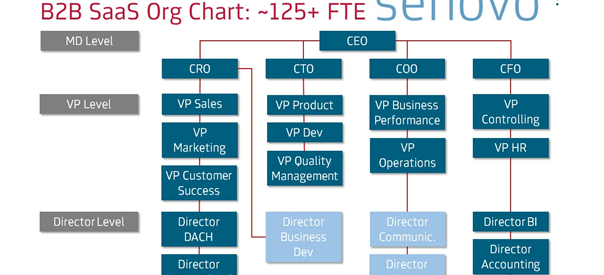Having seen dozens of B2B SaaS (Software-as-a-Service) ventures growing, I have also seen lots of different organizational structures. Some failed, many were adjusted after a while, and very few have been a success from the beginning. Despite of its importance, there is little literature with a specialized focus on B2B software start-ups. Therefore, I want to give venture- as well as non-venture-backed founders some insights into what I have learnt being part of the start-up ecosystem for more than 10 years.
I exclude any aspects of leadership styles as well as micro organizational working cultures, as these aspects would require a separate blog post. Nevertheless, I am highly convinced that depending on the functional departments a close cross-department working approach with clear roles and responsibilities is and will be successful. This may be in a matrix or a network or a pure hierarchical organization. Moreover, I will not dive too much into detail regarding single departments, e.g. the sales department. I would like to focus on key personas I consider crucial in scaling and growing a B2B SaaS start-up as well as their functional responsibilities related to each other.
I assume (for the purpose of illustration) that a B2B SaaS venture is initially founded by three very complementary founders. I present four organizational charts depending on financing stage and number of employees (pre-financing, c. 25 FTEs, c. 50 FTEs, and c. 125+ FTEs). Another assumption is that the company scales and sufficient funding is available in order to ?pre-finance? organizational structuring as well as hiring excellent people. This is the reason why you take on venture capital, right?
I see different levels of responsibility in a growing B2B SaaS company. These levels are structured from top to bottom, i.e. with a growing number of employees the skill set of each level will change:
– MD Level: this level consists of the operating management board, including all founders and/or managing directors. The MDs are jointly responsible for the success of the company. Nevertheless, with a growing team, clear responsibilities should be assigned. A MD must have very good skills in terms of leadership and motivation. Moreover, a hands-on mentality and a generalist approach to solve problems, i.e. out-of-the-box thinking, are needed.
– VP Level: a VP of a certain department needs profound experience in the respective professional area s/he is responsible for. Moreover s/he must have a network of potential team members, experience in recruitment and, above all, leadership skills in order to coordinate teams of 25+, with up to 7?8 direct reports.
– Director Level: a director has already gained leadership skills in a designated professional area before. S/he is responsible for teams of up to 10 team members, including team leads.
– Team Lead Level: a team leader supervises 2?3 people. You even sometimes recruit a team lead without having an actual team in place yet. Leadership experience is often limited. Team members with great potential are often promoted to team leads.
– Team Members: team members are employees with no leadership or any disciplinary guidance role. They are experts at what they are doing. Nevertheless, it is important to foster their skills in leadership in order to be able to promote them to team lead eventually.
According to my experience, founders hire really good additional managers too late. With a stable and predictable business model, the team might grow exponentially. This represents a huge challenge in terms of leadership and corporate culture. One VP sales might be able to handle 5 people, but suddenly struggles to set up structures and lead 25+ people. Therefore, rather spend 1? more on an experienced leader that can also manage a team in years? time.
B2B SaaS Org Chart: before initial investment
If you start your own start-up, it is often hard to distribute certain roles and responsibilities among the founding team. Founders are often generalist people trying to be involved in almost everything related to their venture. Nevertheless, it is important to implement certain responsibilities from the beginning. Not to hold people responsible, but to empower them to make decisions and take actions fast, which is crucial in a dynamic environment like a start-up. A similar approach applies to the first team members. The following separation into three functional roles has proven to be successful for a B2B SaaS venture before any initial financing means: sales & marketing (including customer success, which can be often neglected in the very beginning with no customers at place), product and tech (i.e. software development and product design as well as management), and processes including administration tasks like accounting and legal responsibilities.

B2B SaaS Org Chart: ~25 FTE
After a first seed investment, the founders have the chance to extend the team and create new positions. With three founders you need first team leads managing the operational teams within the three functional areas. These team leads can be either promoted from the initial existing team members or by new external sources. Founders often fear to demotivate existing employees if they recruit a new ?boss? for them. Therefore, they often promote the team members to team leads without challenging their social leadership skills. With regard to this topic there is no right or wrong. However, always think about if the team member you want to promote is also capable of managing double or triple amount of people compared to current status quo. Some might argue that three founders can manage 25 FTEs on their own. They definitely can if the company stays at a level of 25 FTEs. But with a high growth B2B SaaS venture, you always need to be one step ahead.
Moreover, with more people onboard and first customers acquired, the founder?s workload increases drastically. This is why I always recommend hiring a so-called ?Venture Manager? with the first funding round of EUR 1m+. So, what does a venture manager do and what does the profile look like? A venture manager supports the founders with all extraordinary sophisticated projects, e.g. implementing a CRM tool, or one-off intense tasks, e.g. recruitment of several new team members after a new financing round. S/he has a minimum of 4?5 years of work experience in a dynamic environment where s/he had to manage different task at the same time. They often used to work for consulting companies and have an MBA or equivalent business related education. With an expanding venture, sh/e has the chance to grow into a COO type of role in 5 years ? provided that the leadership skills develop accordingly.

B2B SaaS Org Chart: ~50 FTE
When approaching 50 FTEs, you can really call your start-up a company. However, there are more and more tasks that you as a founding partner cannot manage alone anymore. And often your ?personal best friend?, the venture manager reaches his limitations as well. It is time to recruit really good people on the VP level who gained experiences on how to scale, grow and lead large groups and departments in larger organizations. As mentioned above, founders often hire too junior people. The reasons for this are various. I experienced that they mainly want to save money or might have a problem with an ?employee? earning more money than themselves. However, I can tell you this fact is totally normal. You are and should be incentivized by your shareholding ? not your monthly salary. At this stage, it also often happens that one founder either does not fit anymore into the MD leadership role or s/he does not feel comfortable with mainly managing and recruiting people instead of doing operational tasks, which s/he did the years before. This is also normal. Realizing this and acting accordingly by stepping into a different role within the company and hiring a new MD shows great self-reflection and strength. It is super important that the founder team always challenges each other with the question: are we still the right people for the upcoming tasks?
With 50 FTEs on board, it is also the right time to hire an experienced HR manager. The profile should concentrate on recruitment and employee retention ? not administrative tasks like payroll accounting. A former head hunter with experience in employee branding and career path development turned out to be a perfect match (at least 4+ years relevant work experience).
At this stage, the customer structure normally becomes more and more complex. Moreover, internal budgets should be assigned to the VPs and designated departments. Therefore, we recommend hiring a designated finance manager. S/he should have gained prior experience in accounting, controlling, and business intelligence (at least 5+ years of relevant work experience).
On the founder / MD level, the roles and responsibilities shall move into three classical C-level roles, namely Chief Revenue Officer (CRO), Chief Technology Officer (CTO) and Chief Operating Officer (COO including the financing responsibility).

B2B SaaS Org Chart: ~125+ FTE
Until now, scaling the company and setting up the organizational structure was an easy step (I know this is the perspective of an outside investor, our founders would definitely see that differently ? ). When you are approaching the ?100 FTE sound barrier?, things are really getting complicated and cost efficiency often drops. There are many reasons for this inefficiency. With a larger organization, you increase overhead costs. Moreover, performance measures and processes are just about to be implemented at all levels and functional departments ? so lack of performance is still not uncovered.
With more than 100 FTEs you should have reached the EUR 10m+ ARR run-rate level. Provided that you still have nice revenue growth rates, you will be facing the decision if you go for another large investment round of EUR 25m+ or steer the company towards break-even and plan a decent exit process in a year or so. No matter what you decide for, you should look at the US market. Series C and beyond financing rounds are often done by US VCs. Looking at the exit channels for B2B SaaS companies, the US market also plays a dominant role. Therefore, you need to have a strong CFO that can lead large financing or exit processes. The profile sounds simple, but it is not very easy to find. S/he should have at least 8+ years relevant experience as a CFO in a high-growth company. Knowing VC financing processes is mandatory. However, s/he must also be a great people manager as it makes lots of sense that s/he is also responsible for the HR department. When it comes to the US market, a clear CEO role should be in place. S/he is very often one of the founders, but sometimes, it is also an external MD who represents the company as CEO. This is the time when founders and MDs must decide who best represents the company.
Apart from C-level management, several VP and director level positions will be successively added. I would like to point out two positions in particular. The director BI and director implementation. The first one is crucial in order to determine and control capital efficiency. A director BI offers important insights into KPIs und unit economics for the CFO as well as the CRO. The director implementation analyzes how to automate with software tools processes, selects the right tools and implements these ones in the designated departments. Why do you need a designated position for this? I have seen many large companies having many diverse ?island software solutions? in different departments with no interconnection between whatsoever. This increases overhead costs, reduces data and information transparency between departments, and decreases efficiency.
The positions within the illustration above in light blue are optional, i.e. depending on the nature of the B2B business, its customers, different offices, legal structure, capabilities of the team members etc. they can be relevant at this stage or might become later.

My five main learnings
So, how do you get to a successful 125+ FTE B2B SaaS company? These are my top five recommendations for founders who want to scale and structure their organization:
1. Take your time for recruitment! Set up decent processes and do not make premature decisions. Rather reject once a good candidate than hiring once a bad one. This is why you should hire an experienced recruitment manager rather sooner than later. On the other hand: if you hired someone who turns out to not be the right fit, give him a chance to improve. If this does not work out, let him go as soon as possible. Unfortunately, a high growth company has no time to educate people who turn out to be too junior for the position held.
2. Successful CEOs are always recruiting. No matter if you are on holidays or on a customer conference. Always think about your organization and what talents you might need now and in the future. Most CEOs consider 50%+ of their time as people management tasks including recruitment.
3. Never save money on a perfect candidate, just because s/he seems to be too experienced or senior for the current position. Think at least 12?18 months ahead!
4. Don?t feel weak or concerned about your company if you delegate tasks. You will not and cannot be any more on top of all things that happen within your firm. With the right recruitment process in place, you will hire the right people! A venture manager might be a good start.
5. Be flexible! There are some best-practices regarding organizational structures. Nevertheless, if you have met a great candidate for your company and there is no position currently available, hire him regardless ? you will find a spot where s/he will contribute to the success of your firm. Great candidates can do much more than is written in their CVs.
As always, I am happy to receive comments and questions on this very relevant topic via [email protected].


